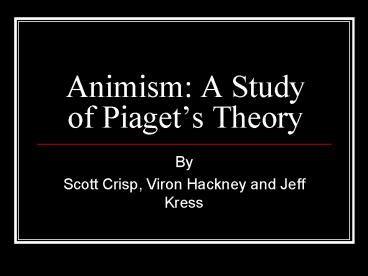Animism: A Study of Piaget - PowerPoint PPT Presentation
1 / 16
Title:
Animism: A Study of Piaget
Description:
Animism: A Study of Piaget s Theory By Scott Crisp, Viron Hackney and Jeff Kress Jean Piaget 1896-1980 Born in Neuchatel, Switzerland to Arthur Piaget and ... – PowerPoint PPT presentation
Number of Views:159
Avg rating:3.0/5.0
Title: Animism: A Study of Piaget
1
Animism A Study of Piagets Theory
- By
- Scott Crisp, Viron Hackney and Jeff Kress
2
Jean Piaget 1896-1980
- Born in Neuchatel, Switzerland to Arthur Piaget
and Rebecca Jackson - Interested in science and philosophy as a child
- Entered the University of Neuchatel, where he
received his Doctorate in science - In 1923 he married Valentine Chatenay, a student
co-worker. They had three children together,
using them as the basis for their intense
research. - In 1950, he published his synthesis, Introduction
to Genetic Epistemology.
3
Animism
- Animism the tendency to regard objects as
living and endowed with a will - Shedding the Animistic thought process occurs
between the Preoperational and Concrete
Operational Stages (roughly 4-8 years of age) - Piaget believed that a child will shed the
Animistic thought process around 8 years of age,
regardless of their status.
4
Inherent Problems
- Does the child attribute consciousness to the
objects around him and in what measure? - (2) What does the concept of Life imply to the
child? - (3) What type of necessity does the child see
in natural laws, moral necessity or physical
determinism ?
5
4 Stages of Animism
- Everything Active is ConsciousStage 1
- Everything that Moves is Conscious.. 2
- Intrinsic Movement is Conscious 3
- Animal World is Conscious. 4
6
Our Hypothesis
- Piaget argues that children reach the point of
understanding animism around the age of 8. We
argue that children as young as 6 can obtain a
reasonable understanding of animism.
7
The Study
- We interviewed 18 students from Holy Family
- 6 students each from 1st, 2nd, and 3rd grade.
- 3 boys and 3 girls from each grade
- Students were asked 16 questions, 4 questions for
each stage in Piagets theory - Based on their answers for each section, we
placed the children in 1 of 4 categories, or
stages, described by Piaget.
8
Eh oh
9
1st Grade
- Ashley (6) Stage 1
- Tessy (6) Stage 1
- Britton (7) Stage 4
- Andrew (6)Stage 4
- Bryce (7) ..Stage 4
- Josh (7) Stage 4
10
Well said..
- No, the chair is made of metal, not blood, so it
wont feel the needle - Josh, 7 - No, the tree can only feel a chainsaw
Andrew, 6 - Uh, No, the sun would melt the needle, duh -
Ashley, 6
11
2nd Grade
- Everett (8)..Stage 3
- Lauren (8).Stage 3
- Sophia (8)..Stage 3
- Juliana (8)..Stage 3
- Arturo (8) ...Almost to 2nd
- Matt (8) Almost to 2nd
12
Oh I see.
- Yea, the mouse will feel the poke, unless you
kill it first - Lauren, 8 - No it doesnt feel the tree, the wind doesnt
have eyes - Juliana, 8 - Are you really gonna poke me with a needle? -
Sophia, 8
13
3rd Grade
- Myriah (9) Stage 4
- Laaiba (8) ...Stage 4
- Tyler (9) .Stage 1
- Kyle (9) ..Stage 3
- Jonathon (9) ..Stage 3
- Lauren (9) ..Stage 2
14
So..
- We were right
- sort of...
15
Terms
- Animism
- Preoperational
- Concrete Operational
- Physical Determinism
- Moral Necessity
16
Do-Overs
- This study would probably have been better if we
had - Interviewed younger children
- Tried our own questions. No offense to the good
doctor, but Piagets questions seemed a bit
outdated































